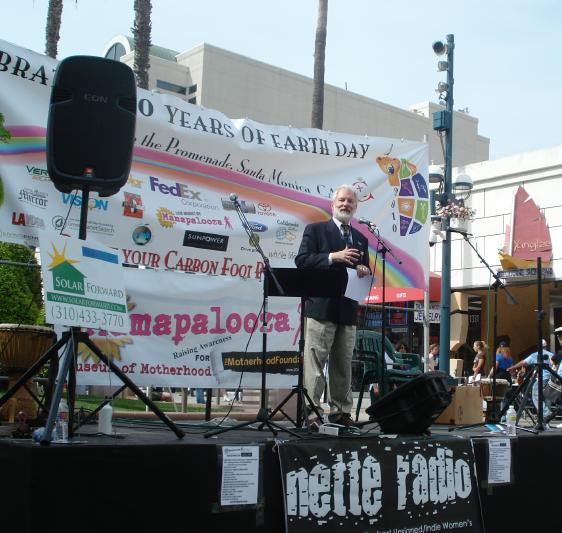Santa
Monica Mall; Saturday, April 17, 2010; 4:00 PM

Nuclear
Weapons on Earth Day
by
Prof.
L. Stephen Coles, M.D., Ph.D., UCLA, Director, PSR-LA
(Physicians
for Social Responsibility - Los Angeles)
Outline for a ten-minute presentation...
The Past, Present, and Future of Nuclear Weapons
Policy
1. The Past [1939 - 1965]
a.
Albert Einstein and other brilliant physicists coauthored a letter to President
Franklin Roosevelt (1939) that helped to
establish The Manhattan Project (under J. Robert Oppenheimer and Gen. Leslie
Groves) which resulted in the design and testing of the first nuclear
weapons
b.
President Harry Truman (1945); Nagasaki and Hiroshima (the first Uranium and
Plutonium Fission Bombs -- ~10 KT’s)
c. The RAND Corporation (1948); Santa Monica (Herman
Kahn, Architect of Strategic Nuclear Policy Thinking about the Unthinkable;
Richard Bellman Dynamic Programming; Simon, Newell, and Shaw invented the
IPL Language on the Johnniac Computer –
named for John von Neumann; Simon won the Nobel Prize for
Economics)
c.
Edward Teller (1951) The Hydrogen Bomb (Fusion – [2 - 50] MT’s)
d.
Above Ground Nuclear Testing was halted (1963)(PSR was instrumental in this
step)
e. SDC (1963) USAF Strategic Air Command Control
System, (465L); Post Attack Control System (computer simulation of winds at
different altitudes determines an elliptical or butterfly pattern of
radioactive fall-out over different American cities)
f. ARPA
(1965) in the Pentagon’s OSD DDR&E (The Cuban Missile Crisis: Presidents
John Kennedy and Nikita Khrushchev; Russian wives cry at Sheremetyevo
Airport in Moscow as their husbands leave for the UN to negotiate in NYC, which
was multiply targeted by the USSR)
2. The Present (2010)
(Breaking News: President Obama will not attend the funeral of the
late Polish President, as Air Force 1 cannot fly to Warsaw, secondary to the
heavy volcanic ash from Iceland that has shut down most European
airports.)
a. “New START” signed one week ago in Prague, Czeck Republic by Presidents Obama and Russian President Medvedev
to reduce respective stockpiles by 30 percent (The US Senate and The Duma in Moscow must still ratify; We need a 2/3rd
majority). Our California Senators (Sens.
Feinstein and Boxer) will vote for it, but it could become a partisan issue, with
voting deliberately delayed by Republicans until after the November
elections.
b. Washington,
D.C. (on Tuesday; 47) world leaders met (without North Korea or Iran) to Secure
Nuclear Materials by the year 2014 (it was not a particularly successful
meeting – no implementation schedule; only agenda-talk; no teeth)
c. Next month, in May, there will be a Review
Conference at the UN HQ in NYC on redesigning the Nuclear Nonproliferation
Treaty
3. The Future (>2011)
I don’t have a crystal ball (US, Russia, UK, France,
and China have weapons).
a. Russian/American Cold-War-type massive exchange is
unlikely, but there are other countries:
1. South Korea/North Korea (3 or 4
weapons)
2. Pakistan/India (80 weapons, each)
3. Iran/Israel (50 weapons)
b. Dirty Bomb bought on the black market/infiltrated
by terrorists: Al Queda and/or the Taliban
(Can the FBI even finger-print the source/origin of
the perpetrators? There’s no disincentive by MAD (Mutually Assured Destruction)
even if we know who did it; A. Q. Kahn, the architect of the Pakistani bomb who
sold technology to Iran, is viewed as a hero in his home country. Pakistan
fears India more than they do a worldwide nuclear annihilation (How crazy is
that?)
c. What can we to do about
it?
1. “No First Use” Policy; (almost complete except
for chemical/biological WMD);
2. Don’t
design and build new warheads (such as the alleged Reliable Replacement Warhead
designed and promoted by Lawrence Livermore Labs); and
3. We must take the launch of nuclear weapons off
high-alert status (15 minutes) (“The Football” contains the secret launch codes
in a suitcase that follows the President wherever he travels). One should reset the launch time for at least
24 hours. There are too many
opportunities for error.